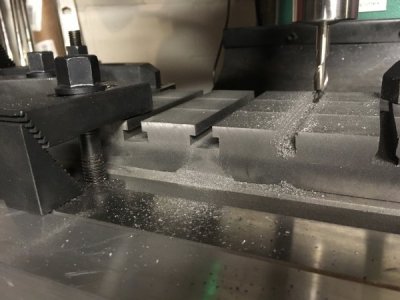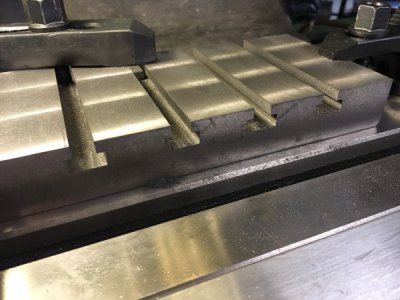-
Welcome back Guest! Did you know you can mentor other members here at H-M? If not, please check out our Relaunch of Hobby Machinist Mentoring Program!
You are using an out of date browser. It may not display this or other websites correctly.
You should upgrade or use an alternative browser.
You should upgrade or use an alternative browser.
mla tee slot cross slide
- Thread starter eric chilton
- Start date
- Joined
- Dec 3, 2017
- Messages
- 1,909
2 more slots done. I think each one is taking about an hour. This seems like a long time. I used a 5/16” corn cob type rougher on the “in progress” slot. I think this may help speed it up. And I’m pretty sure the t slot cutter will be dead by the end of this project. I’m probably doing many things wrong.
Attachments
- Joined
- Apr 12, 2013
- Messages
- 562
I had to outsource mine. It does stiffen the QCTP noticeably. Overall I think you'll be happy with the end result. I just use a protractor off the face of the chuck to set compound angles. It is probably more accurate than the degree marks anyway!
- Joined
- Dec 3, 2017
- Messages
- 1,909
Tee slots are done. The most efficient strategy was to use a 5/16 rougher at full depth, followed by a 3/8” 4 flute end mill at full depth, followed by the t slot cutter. This was at 317 rpm. I’m estimating that cut the time in half at least. I’d started by slowly milling(3/8”) out the slots .020-.030” at a time. Which ended up being about 15 passes back and forth. So slow. Really no fun for me.
Attachments
- Joined
- Feb 26, 2014
- Messages
- 256
That is not necessarily correct, I have the MLA on my 12" Atlas with a solid block mount for the tool post and cut threads successfully just plunging straight in with the cross slide. StuThe T-slot cross slide, other things being equal, is more rigid that the stock one with the compound. However, without the compound and compound swivel, you can't cut threads properly. So either adapt the compound and swivel to the T-slot or keep both.
- Joined
- Dec 25, 2011
- Messages
- 10,511
Then you have been lucky or haven't had to thread across an interruption. The reason for the practice of setting the compound around to 29.5 to 30 degrees is to insure that the half nuts are always pushed back against the leading edge of the threads on the lead screw. If for some reason, you had to thread across a cross-hole, the carriage could tend to jump toward the headstock as the leading edge of the tool entered the hole with the trailing edge still cutting. In general, you always want the reaction forces to be only in the direction to hold the half nuts firmly against the lead screw leading edge. The same thing would tend to happen to the last half thread if threading up to a pull-out relief groove.
- Joined
- Feb 26, 2014
- Messages
- 256
Then you have been lucky or haven't had to thread across an interruption. The reason for the practice of setting the compound around to 29.5 to 30 degrees is to insure that the half nuts are always pushed back against the leading edge of the threads on the lead screw. If for some reason, you had to thread across a cross-hole, the carriage could tend to jump toward the headstock as the leading edge of the tool entered the hole with the trailing edge still cutting. In general, you always want the reaction forces to be only in the direction to hold the half nuts firmly against the lead screw leading edge. The same thing would tend to happen to the last half thread if threading up to a pull-out relief groove.
I've never heard that explanation before, the common reason I'm aware of is that the cutting forces are less when the tool is just cutting one side of the thread. I do see your point and it does make sense. I've never had to single point with an interrupted cut before, so I'll keep that in mind. I can put the compound back on the cross slide, but much prefer the rigidity without it. Stu
- Joined
- Sep 14, 2014
- Messages
- 438
Do you have any suggestions for the gib? I managed to put a huge bow in mine. Still Haven't figured out how I did it but don't want to do it a second time. I held it in place with drill rod and adjustable parallels.
- Joined
- Dec 25, 2011
- Messages
- 10,511
Bill,
No. The "common reason" is mostly false. The volume of metal removed in either case is almost the same. Feeding straight in some number of thousandths of an inch will be removing slightly more metal by volume (1/0.866 times what would be removed if the in-feed were done by the compound set at 30 deg.) and only half of it by the leading edge of the cutter.
No. The "common reason" is mostly false. The volume of metal removed in either case is almost the same. Feeding straight in some number of thousandths of an inch will be removing slightly more metal by volume (1/0.866 times what would be removed if the in-feed were done by the compound set at 30 deg.) and only half of it by the leading edge of the cutter.
Last edited:



